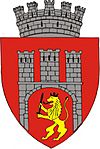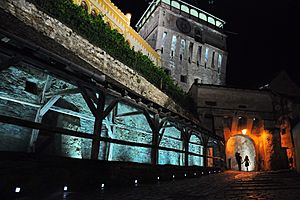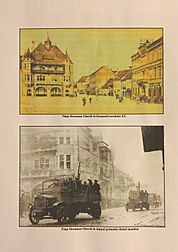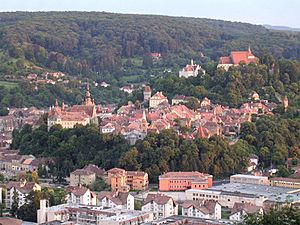Sighișoara facts for kids
Quick facts for kids
Sighișoara
|
||
|---|---|---|
|
City
|
||
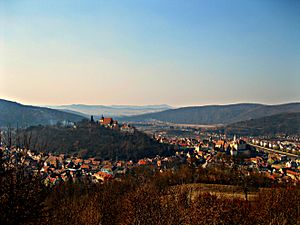
Panoramic view of the city from one of the surrounding hills
|
||
|
||
| Country | ||
| County | Mureș County | |
| Status | Municipality | |
| Population
(2011)
|
||
| • Total | 28,102 | |
| Time zone | UTC+2 (EET) | |
| • Summer (DST) | UTC+3 (EEST) | |
| Website | http://www.sighisoara.org.ro/ | |
| Official name: Historic Centre of Sighișoara | ||
| Type: | Cultural | |
| Criteria: | iii, v | |
| Designated: | 1999 (23rd session) | |
| Reference #: | 902 | |
| Region: | Europe | |
Sighișoara is a city on the Târnava Mare River in Mureș County, Romania. Located in the historic region of Transylvania, Sighișoara has a population of 28,102 according to the 2011 census. It is a popular tourist destination for its well-preserved walled old town, which is listed by UNESCO as a World Heritage Site.
The city administers seven villages: Angofa, Aurel Vlaicu, Hetiur, Rora, Șoromiclea, Venchi and Viilor.
Contents
History
During the 12th century, German craftsmen and merchants known as the Transylvanian Saxons were invited to Transylvania by the King of Hungary to settle and defend the frontier of his realm. The chronicler Krauss lists a Saxon settlement in present-day Sighișoara by 1191. A document of 1280 records a town built on the site of a Roman fort as "six-sided camp", referring to the fort's shape of an irregular hexagon. Other names recorded include Schaäsburg (1282), Schespurg (1298) and Segusvar (1300). By 1337 Sighișoara had become a royal center for the kings, who awarded the settlement urban status in 1367 as the Civitas de Segusvar.
The city played an important strategic and commercial role at the edges of Central Europe for several centuries. Sighișoara became one of the most important cities of Transylvania, with artisans from throughout the Holy Roman Empire visiting the settlement. The German artisans and craftsmen dominated the urban economy, as well as building the fortifications protecting it. It is estimated that during the 16th and 17th centuries Sighișoara had as many as 15 guilds and 20 handicraft branches. The Baroque sculptor Elias Nicolai lived in the city. The Wallachian voivode Vlad Dracul (father of Vlad the Impaler (Dracula)), who lived in exile in the town, had coins minted in the city (otherwise coinage was the monopoly of the Hungarian kings in the Kingdom of Hungary) and issued the first document listing the city's Romanian name, Sighișoara. The Romanian name is first attested in 1435, and derives from the Hungarian Segesvár, where vár is "fort".
The city was the setting for George I Rákóczi's election as Prince of Transylvania and King of Hungary in 1631. Sighișoara suffered military occupation, fires, and plagues during the 17th and 18th centuries. An important source for the history of 17th-century Transylvania, for the period of 1606-1666, are the records of Georg Kraus, the town's notary.
The nearby plain of Albești was the site of the Battle of Segesvár, where the revolutionary Hungarian army led by Józef Bem was defeated by the Russian army led by Luders on 31 July 1849. A monument was constructed in 1852 to the Russian general Skariatin, who died in the battle. The Hungarian poet Sándor Petőfi is generally believed to have been killed in the battle, and a monument was constructed in his honor at Albești in 1897. After World War I Sighișoara passed with Transylvania from Austria-Hungary to the Kingdom of Romania.
Central Sighișoara has preserved in an exemplary way the features of a small medieval fortified city. It has been listed by UNESCO as a World Heritage Site. Each year, a Medieval Festival takes place in the old citadel in July.
Sighișoara is considered to be the most beautiful and well-preserved inhabited citadel in Europe, with authentic medieval architecture. In Eastern Europe, Sighișoara is one of the few fortified towns that are still inhabited. The town is made up of two parts. The medieval stronghold was built on top of a hill and is known as the "Citadel" (Cetate). The lower town lies in the valley of Târnava Mare river.
The houses inside Sighișoara Citadel show the main features of a craftsmen's town. However, there are some houses that belonged to the former patriciate, like the Venetian House and the House with Antlers.
In 2001-2003 the construction of a Dracula theme park in the 'Breite' nature preserve near Sighișoara was considered but ultimately rejected, owing to the strong opposition of local civil society groups and national and international media as well as politically influential persons, as the theme park would have detracted from the medieval style of the city and would have destroyed the nature preserve.
Twin towns
 Dinkelsbühl (Germany)
Dinkelsbühl (Germany) Kiskunfélegyháza (Hungary)
Kiskunfélegyháza (Hungary) Baden (Switzerland)
Baden (Switzerland) Blois (France)
Blois (France) Città di Castello (Italy)
Città di Castello (Italy)
Images for kids
See also
 In Spanish: Sighișoara para niños
In Spanish: Sighișoara para niños


